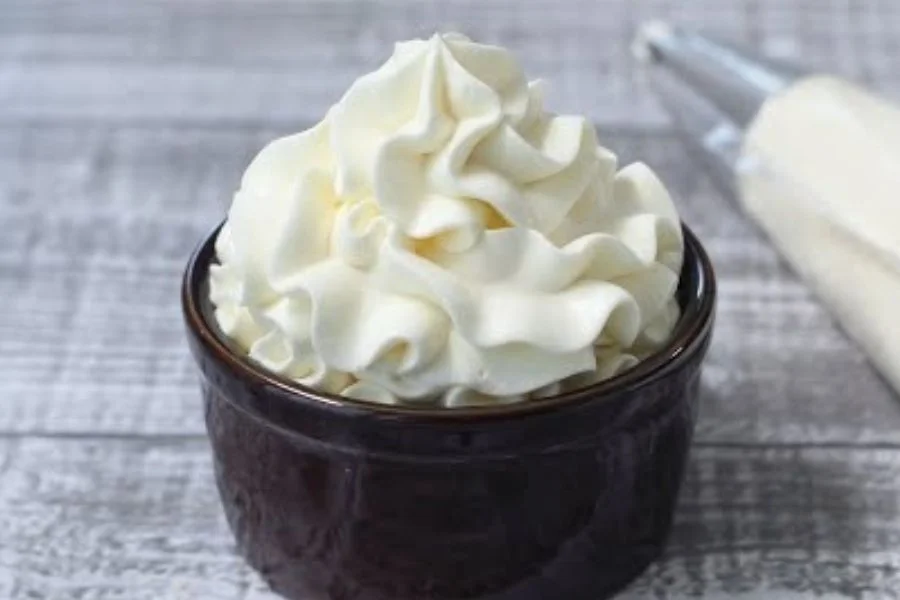Let me introduce you to a creamy delight called Namelaka. Imagine a dessert that’s like a mix of ganache and mousse but even smoother and more luxurious. That’s namelaka for you!
A smooth, creamy wonderland that’ll make your taste buds dance with joy! It’s rich but not overly sweet, and you can get creative with flavors. Add fruit purees, extracts, or whatever you like to make it unique.
Namelaka is perfect for all sorts of desserts. Fill cakes with it, top tarts, cupcakes, or pastry. You can even serve it in dessert cups or as a dip for fruit. The fun doesn’t stop there. If you store Namelaka right in the fridge, it can be your dessert buddy for a few days. Just remember to let it come to room temperature before using it again. It’s incredibly silky and packed with intense chocolate flavor.
You can make Dark Chocolate Namelaka without adding extra sugar. It’s balanced and not too sweet! It’s lighter and more delicate than mousse or custard but sturdy enough for piping. That makes it great for frosting cupcakes, decorating cakes, or filling pastries.
May You Like
The story behind the recipe
As far as I know, the namelaka recipe started in Japan. The name “namelaka” comes from two Japanese words: “nama,” which means “fresh” or “raw,” and “laka,” which is from the French word “laque,” meaning “lacquer” or “varnish.” This name shows how smooth and creamy the dessert is, like lacquer.
Namelaka is a dessert that’s been developed and improved by many chefs, so it’s hard to say where it came from exactly. While the most famous kind is chocolate namelaka, you can add other flavors like fruit purees, caramel, coffee, or tea to make it unique.
A famous Japanese pastry chef, Yasumasa Takagi, who started “Le Chocolat de H,” came up with the namelaka technique. He introduced this new kind of creamy texture in the early 2000s. It’s a way to make desserts with a velvety texture that isn’t too heavy or dense.
How to make Namelaka

Ingredients
- 150g white chocolate (You can also use dark or milk chocolate to create different flavors)
- 2 tbsp cold water
- 250ml heavy (whipped) cream
- 1 tsp gelatin powder
Step-by-step instructions for making namelaka
- Sprinkle the gelatin powder over some cold water in a small bowl. Let it sit for a bit until it turns soft and soaks up the water.
- Cut the white chocolate into small pieces and put them in a heatproof bowl. You can melt it using a microwave or a double boiler. If you use a microwave, heat it in short bursts, stirring in between until it’s smooth. With a double boiler, put the bowl over simmering water and stir until the chocolate is melted.
- In a saucepan, heat up the heavy cream over medium heat until it’s almost boiling. Take it off the heat just before it starts boiling.
- Add the soaked gelatin to the warm cream and stir until the gelatin disappears.
- Pour the warm cream mix over the melted chocolate. Let it sit for a minute to let the chocolate soften, then gently stir until it’s smooth and glossy.
- If you want an extra smooth and creamy texture, you can use an immersion blender or a regular one to mix the namelaka. Be careful to avoid making air bubbles.
- Cover the namelaka mix with plastic wrap, making sure it touches the surface to stop skin from forming. Put it in the fridge for at least 4 hours, or even better, overnight, until it becomes spreadable.
Tips for Namelaka
- When you’re melting the chocolate with the milk or cream, it’s better to use an immersion blender instead of a spatula. But be careful not to move the blender up and down, or you’ll make a bunch of air bubbles.
- For the tastiest namelaka, use top-notch chocolate and fresh heavy cream. The better the ingredients, the better your namelaka will be, both in taste and texture.
- Don’t forget to prep the gelatin right. Sprinkle it over cold water and let it sit before you use it. Stir it well to make sure there are no lumps of gelatin in your namelaka.
- And remember, don’t skip the long chilling time! It’s super important for the cocoa butter to slowly turn into crystals, which give you that amazingly smooth texture and a silky, melt-in-your-mouth taste.
Flavourful substitute
Gelatin: If you’re looking for a vegetarian or vegan option, you can use agar-agar instead of gelatin. Follow the instructions on the agar-agar package for the right measurements and preparation.
White Chocolate: You can replace white chocolate with dark or milk chocolate for different flavor variations. Use the same amount as the recipe suggests.
Heavy Cream: For a lighter option, you can use half-and-half or whole milk instead of heavy cream. Just keep in mind that it might result in a slightly different texture and flavor.
Remember that these substitutions might alter the final taste and texture of your namelaka, so choose the one that best suits your dietary preferences and the flavor you desire.
Serving suggestions
As a Dessert: Serve namelaka in individual dessert cups or glasses, topped with fresh berries, a drizzle of fruit coulis, or a sprinkle of chocolate shavings.
Cake Filling: Use namelaka as a luscious filling for cakes, tarts, or pastries. It adds a creamy and rich layer to your baked goods.
Macarons: Put namelaka between two macaron shells for a fancy and tasty macaron treat.
Dipping Delight: Offer a variety of dippable items like fruit slices, pretzels, or cookies alongside your namelaka for a fun and interactive dessert experience.
Tarts: Put namelaka in already baked tart shells, and add fresh fruits or berries on top. It goes great with fruit tarts like raspberry, strawberry, or mixed fruit tarts.
Accompaniment for Churros: Pair namelaka with freshly fried churros for a fantastic combination of textures and flavors.
Waffles: Pour namelaka over freshly made waffles and add fruits or a little powdered sugar on top.
Topping for Sundaes: Spoon some namelaka over your favorite ice cream flavors to create a delightful sundae with a silky twist.
Coffee or Tea Companion: Serve namelaka with a cup of coffee or tea as a luxurious accompaniment for a delightful afternoon treat.
Dessert Platter: Include namelaka as part of a dessert platter alongside other sweet treats, like macarons, petit fours, or mini cheesecakes.








